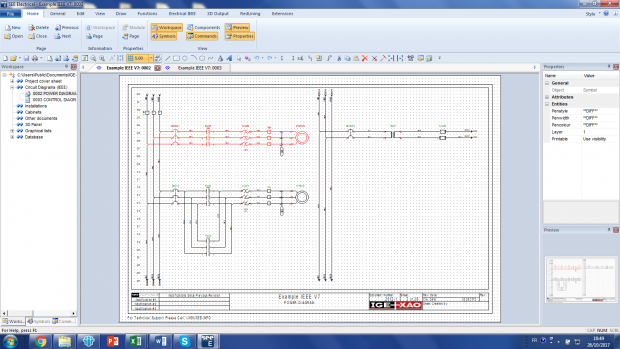ECAD Software Handles Different Work Settings

Designed by and for electrical engineers, SEE Electrical is offered in versions that address all levels of required functionality from the single engineer through large workgroups. Image courtesy of IGE-XAO Group.
January 9, 2018

Finding schematic software for controls, panels or countless other electrical systems can put you in Goldilocks' world: You seem to sample tools that provide too little or too much functionality. Often that's because some ECAD software is just CAD with a veneer of generic electrical engineering tools. Today's Check it Out link takes you to details on three ECAD solutions designed from the get-go to be just right for all levels of electrical engineering, and you can sample it for 30 days.
IGE-XAO recently announced an update of its SEE Electrical v8 software for electrical wiring diagramming. For better than three decades IGE-XAO has developed ECAD solutions for shops as small as the lone wolf consultant to large staffs focused on automation, manufacturing, machinery, energy production, aerospace and transportation. Hard-wired to think as electrical engineers, their portfolio includes PLM (product lifecycle management), project management, simulation software and other applications dedicated to electrical engineering systems.
 Designed by and for electrical engineers, SEE Electrical is offered in versions that address all levels of required functionality from the single engineer through large workgroups. Image courtesy of IGE-XAO Group.
Designed by and for electrical engineers, SEE Electrical is offered in versions that address all levels of required functionality from the single engineer through large workgroups. Image courtesy of IGE-XAO Group.SEE Electrical comes in Basic, Standard and Advanced versions, enabling you to choose what you need. Various modules extend the software for assignments like 2D cabinet layout and 3D panel manufacturing. One interesting module provides intelligent drawing legacy handling for maintenance services and departments managing paper or DXF/DWG plans. Interfaces for workgroup systems are available.
The Basic version is the SEE Electrical launchpad. It provides tools for schematic design as well as product, terminal and cable reporting. It also offers customizable templates and DWG/DXF import/export capabilities.
At the Standard level, key features include automatic wire numbering, BOM (bill of materials) generation and part lists. It introduces an on-demand, online parts database with access to equipment codes as well as equipment symbols from various manufacturers.
The Advanced version brings capabilities like automatic project generation, graphical terminal cable and connector plans, PLC spreadsheet data import, nested functions and project management.
After landing on the SEE Electrical page, look for the blue hyperlink type. Click on the “discover main features link,” then hit the link for the 30-day demo version. A well-done video at the bottom of the page provides a narrated comparison of the three editions. SEE Electrical's clean interface and speedy performance really stand out. You'll likely be surprised at the power of the Basic edition.
Creating wiring diagrams is an art and a critical discipline. SEE Electrical seems to address both of these dimensions with aplomb. Hit today's Check it Out link to learn more about SEE Electrical.
Thanks, Pal. – Lockwood
Anthony J. Lockwood
Editor at Large, DE
Subscribe to our FREE magazine, FREE email newsletters or both!
About the Author
Anthony J. Lockwood is Digital Engineering’s founding editor. He is now retired. Contact him via [email protected].
Follow DERelated Topics







